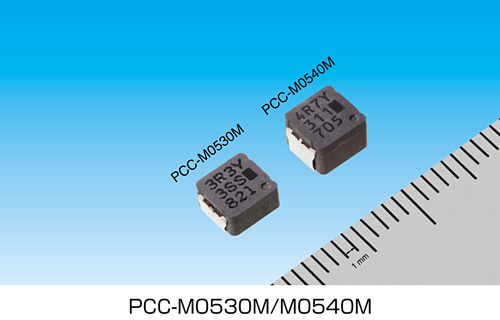Osaka, Japan - Panasonic Corporation today announced the release of a new power choke coil for automotive applications, featuring one of the lowest DC resistances in the industry*1, and a compact size, in addition to being suitable for large current applications. The new power choke coil is suitable for power supply circuits of Electronic Control Units (ECUs) for gasoline, HEV and EV vehicles and will be released in October, 2013.
In order to achieve the high requirements for the environment and low fuel consumption, the number of control functions for the ECU of an in-vehicle engine, including the rapid and fine control of combustion, intake, and exhaust gas, is increasing. In addition, as the number of ECUs in non-engine applications increases, there is a growing requirement for smaller, lighter and integrated ECUs. This has led to the central processing units (CPUs) of ECUs having a higher clock speed and lower voltage, and the power supply circuits to drive CPUs incorporating high efficiency DC/DC converters are becoming more common.
Against this background, the power choke coils mounted on DC/DC converters are required to be small in size and capable of supporting a high current, while being resistance to heat and vibrations. To meet the market demand, Panasonic has succeeded in commercializing a power choke coil suitable for in-vehicle power supply circuits, with one of the lowest DC resistances in the industry*1.
Panasonic will start mass production of the new power choke coil October 2013, with a monthly production capacity of 7 million pieces. The company will contribute to saving space and the fine control of power supply circuits used in in-vehicle engine control units.
Features of the New Power Choke Coil for Automotive Applications
- One of the lowest resistances in the industry*1 (36 mΩ)
- Compact size and large current, saving space in power supply circuits used in ECUs
Approx. 40 % reduction in volume, compared with our current models*2
Current value: 4.0A
- Low loss, improving the efficiency of the power supply and enabling an increase in the number of ECUs and control functions, in addition to simplifying circuit design for heat dissipation and other features
- Excellent heat and vibration resistance properties, suitable for ECUs in severe environments
Vibration-resistance: 5 Hz to 2 kHz/15 G
Notes:
*1 As of September 30, 2013, based on Panasonic's own investigation of choke coils with metal composite structure
*2 Panasonic's current models: PCC-M0645M series
Applications:
Engine ECUs for HEVs, gasoline cars, and power supply circuits of a variety of ECUs.

About Panasonic
Panasonic Corporation is a worldwide leader in the development and engineering of electronic technologies and solutions for customers in residential, non-residential, mobility and personal applications. Since its founding in 1918, the company has expanded globally and now operates over 500 consolidated companies worldwide, recording consolidated net sales of 7.30 trillion yen for the year ended March 31, 2013. Committed to pursuing new value through innovation across divisional lines, the company strives to create a better life and a better world for its customers. For more information about Panasonic, please visit the company's website at http://panasonic.net/.
Media Contacts:
- Tokyo Public Relations Office
Panasonic Corporation - Tel:03-3574-5664 Fax:03-3574-5699
- Panasonic News Bureau
- Tel:03-3542-6205 Fax:03-3542-9018







